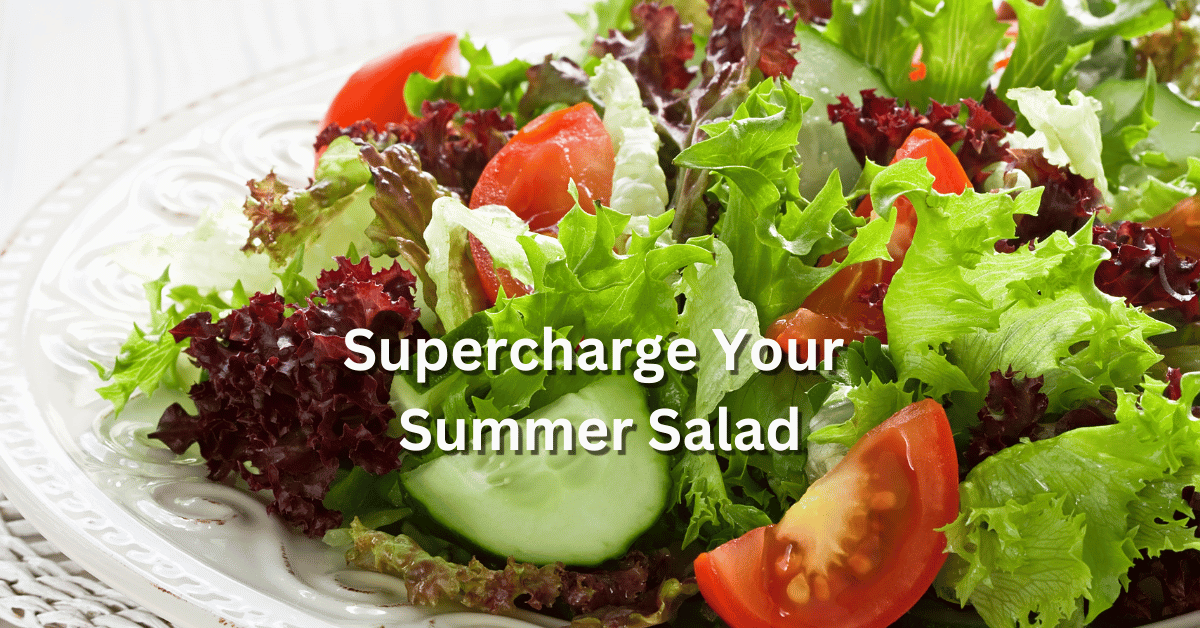Salads can be so much more than a simple bowl of lettuce with a few veggies tossed in. They offer a world of nutrient-rich mealtime possibilities, combining interesting flavor, texture, and color. When temperatures rise and produce is at its peak, supercharge your summer salad to enjoy a refreshing meal that doesn’t require hovering over a hot stove. In fact, it is a cooking-free meal!
Building the Foundation for Your Summer Salad
When building super summer salads, start with a bed of greens. Choose colorful, nutrient-dense lettuce and leafy green varieties, including romaine, red and green leaf lettuce, radicchio, arugula, spinach, kale, Bibb, and endive. Continue with your choice of seasonal fruits and vegetables, such as blueberries, raspberries, watermelon, sliced peaches, shredded carrot, sliced radishes, roasted beets, and sliced cucumber. Grilled or sautéed zucchini, bell peppers, asparagus, and corn also add great flavor and texture. Are you looking for ideas? Check out the Mediterranean Diet.
Add Whole Grains and Protein-Rich Foods
While these crave-worthy salads made with interesting greens and seasonal produce are delicious, there’s no reason to stop there. Supercharge your summer salad by adding whole grains such as brown rice, bulgur, barley, or farro; toasted almonds, walnuts, pecans, pistachios, pumpkin seeds, or other flavorful nuts and seeds; and protein-rich foods like chicken, beans, and seafood.
Fuel with Fiber
When planned appropriately, supercharged summer salads can help meet daily fiber and protein needs. More than 90% of women and 97% of men don’t meet the daily fiber intake recommendations of 25 g for women and 31 g for men. Adding fiber-rich foods, including avocados (1/2 cup: 5 g), raspberries (1/2 cup: 4 g), sunflower seeds (1 oz: 3 g), pistachios (1 oz: 3 g), cooked lentils (1/2 cup: 7.8 g), and cooked chickpeas (1/2 cup: 6.3 g) can help fill the fiber gap.
Power Up with Protein
When topped with grilled or rotisserie chicken, grilled salmon or shrimp, beans and nuts, or hard-boiled eggs, a salad made with lettuce and fresh veggies can quickly become a hearty main meal for lunch or dinner, complete with high-quality protein.
Topping It Off: Dressing Choices
Salad dressings come in a variety of options and offer the opportunity to enhance the natural flavors of the ingredients. The classic mix of olive oil and vinegar or lemon juice is low in added sugar and simple to put together. Other low-sugar choices include homemade poppyseed dressing made with plain Greek yogurt, vinegar, and a drizzle of honey; a simple vinaigrette with olive oil, balsamic vinegar, Dijon mustard, and garlic or shallot; and a blended green dressing with light mayonnaise, lemon juice, chopped leafy herbs such as basil and/or parsley, and garlic.
Hydration with Your Salad
Staying well-hydrated is important for overall good health. It helps regulate body temperature, deliver nutrients to cells, remove wastes from the body, prevent infections, relieve constipation, and may also help improve cognition and mood. Drinking plenty of water, especially during the heat of summer, is key. Summer produce with high water content, including watermelon, berries, tomatoes, cucumbers, zucchini, and celery, can also help quench thirst.
Conclusion
By following these tips, you can supercharge your summer salad and enjoy a nutrient-dense, flavorful, and refreshing meal. Incorporating a variety of greens, seasonal produce, whole grains, and protein-rich foods ensures that your salad is not only delicious but also beneficial for your health. Stay hydrated, enjoy your meals, and make the most of the vibrant summer produce.

